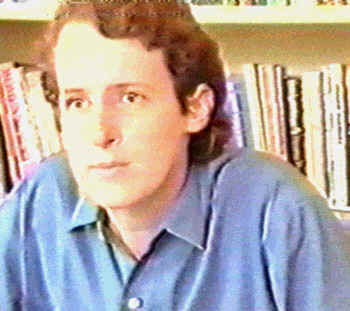
By: T. Sabaratnam
(Volume 2)
13. The Love StoryAdele’s Influence
The third and fourth matters on which Pirapaharan’s attention was focused during the closing months of 1983 were interestingly intertwined. They involved the theoretical issue of the role of women in the freedom struggle and Pirapaharan’s personal life.
The
general
issue
of
women’s
emancipation
and
the
freedom
struggle
was
brought
to
the
attention
of
Pirapaharan
by
Adele
Balasingham,
who
published
a
book
Women
and
Revolution
in
late
1983
in
Chennai.
In
that
book
Adele
took
up
three
strong
positions.
Firstly,
she
argued
that
women
in
any
oppressed
society
have
the
right
to
oppose
the
oppression
and
defend
their
people.
That
gives
women
the
opportunity
to
realize
their
patriotic
sentiment.
Secondly,
women’s
participation
in
the
national
freedom
struggle
helps
to
strengthen
it.
It
would
not
weaken
the
struggle
as
generally
feared.
Thirdly,
involvement
in
the
national
struggle
provides
space
for
women
to
struggle
for
women’s
emancipation.
Women’s
direct
participation
in
the
national
struggle
paves
the
way
for
the
total
liberation
of
the
society.
Adele Balasingham (courtesy www.tamilcanadian.com)
I tried to find out whether Adele’s booklet was discussed by the others who lived at Thiruvanmiyur and Adayar. No one remembered the book or any discussion about it. Their central focus at that time was on the Indian training program. But Adele in her book The Will to Freedom says that Pirapaharan told her that many young Tamil women were working with the LTTE. He told her that they were involved in different activities of the struggle.
She adds that Pirapaharan also read to her letters from women activists requesting him to arrange military training for them to make their participation in the fight against state brutality deeper and wider. In those letters the women had indicated their desire to get involved in the ‘people’s defence against brutal oppression.’ Pirapaharan told her his intention to work on a program for the induction of women into the armed struggle.
And that process started in a totally unexpected manner.
The Death Fast
The 1983 July riots and the attack on the Tamil students of Peradeniya University on 12 and 13 May, two months before the riots, had displaced all Tamil university students who studied at the universities of Colombo, Peradeniya and Moratuwa. They fled to the north and east, their homeland. When the University Grants Commission (UGC) announced the reopening of the southern Universities, Tamil students refused to return. They said they feared for their lives and requested that they be transferred to Jaffna University.
The UGC turned down the students' request and directed them to attend lectures or suffer the consequences. The students decided to protest. They organized a fast at the Jaffna University campus. All Tamil militant groups supported the fast. GUES, the student organization of EROS, took charge of the propaganda. It whipped up feeling in the student community in the Jaffna peninsula.
The UGC was adamant. It issued an ultimatum that the students should report to the registrars of their respective universities before the end of November. Some students decided to break ranks saying
they did not want to forgo their university studies. The LTTE then issued a leaflet on 7 November titled: Do not go to Killing Fields. The leaflet said returning to the southern universities would be dangerous to the Tamil students. It said Sinhala chauvinism would not mind turning the universities into Welikadas, referring to the prison massacres.The government announced that it was not prepared to yield to pressure from Tamil students. The UGC told the universities to commence lectures from January. This angered the Tamil people. A student fast gained public sympathy. Large crowds thronged the Jaffna university campus daily to express their solidarity with the fasting students. School students boycotted classes and took out processions. Black flags were hung throughout the Jaffna peninsula. Tension mounted. Militant groups burnt government vehicles.
Nine students – four girls and five boys – launched a death fast on 9 January 1984. The government ordered the closure of Jaffna University. That failed to dislodge the fasting students. On the sixth day a fasting woman student fainted. Doctors were summoned. They pronounced that her condition was fast deteriorating. The condition of the other students was also disturbing.
Jaffna
University
2002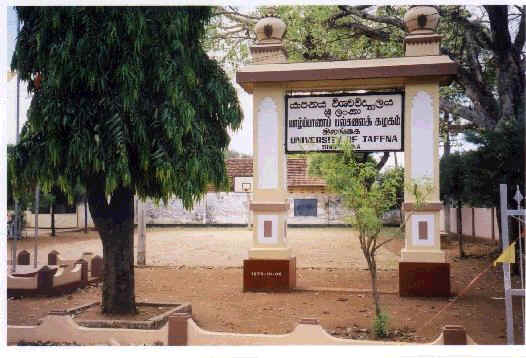
The government did not relent. Its spokesman, Trade and Shipping Minister Lalith Athulathmudali, announced that the government would not be intimidated by death fasts. Around 11 p.m. on 16 January, the seventh day of the fast, armed youths forcibly carried all fasting students to waiting vans and whisked them away. The group, led by Victor, took them to the LTTE hideout at Atchuveli. They were fed there and transported by boat to Tamil Nadu.
The LTTE’s action to forcibly terminate the death fast was criticized by other militant groups, particularly by GUES and PLOTE. It was an unnecessary and unwarranted interference with the freedom of protest, a PLOTE statement said.
The LTTE issued a statement explaining its decision. The statement said:
We took the students in order to save their lives. We took them with their full consent. Now, they are eating and are in good health.
Students should not be allowed to die. If they had died due the fast the government would not have repented. We saved the fasting students because the government would not listen to non-violent protest.
LTTE propagandists made use of the university student fast to din into the minds of the Tamil people the futility of non-violent protests. They said Jayewardene's government, which had won the 1977 election promising to set up a ‘dharmista’ (just and fair) government, had become brutal. It stifled trade union strikes and non-violent protests using armed thuggery and the armed might of the state. The only language Jayewardene's government understood was the language of the gun.
Mathi’s Prank
The students were first taken to Madurai and treated at a private hospital. Pirapaharan did not want to have the girls with them in Madurai or send them to the training camp. He informed Adele that four Jaffna girls would be coming to her house and she would have female company.
What happened at the Thiruvanmiyur residence of the Balasinghams is told by Adele in her book The Will to Freedom. What follows is mainly based on her narrative with a few additional details I have been able to gather.
The four girls sent by Pirapaharan were: Mathi (Mathivathani), Vinoja, Jeya and Lalitha. Of them the lean, tall, fair, pleasant and playful Mathi was the most attractive. The Time correspondent who saw her during a press interview in 1985 called her a ‘fiery beauty.’ Mathi was from the village Madathuveli in Punguduthievu. Her mother's name was Sinnammal. Her father Earambu was a teacher and known in the village as Earambu Master. His was a pious religious family which practiced the Hindu religion strictly. Mathi was also pious, religious, gentle and caring.
Mathi was clever and did well in studies. She was selected to the university to do veterinary science but opted to study agricultural science, an unmistakable influence of her agricultural background. She was in her second year when attacks on Tamil students in Peradeniya University took place. She returned to her Punguduthievu home and stayed with her parents till the death fast began.
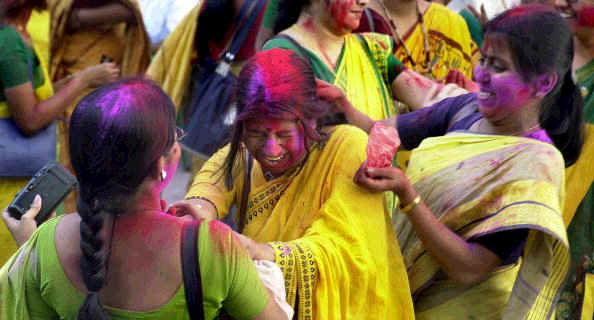 The
entry
of
the
four
girls
did
cause
some
embarrassment
to
the
almost
male
(Adele
was
older)
preserve
of
the
Thiruvanmyur
home,
but
they
brought
mirth
and
liveliness
to
an
almost
boring
abode.
The
girls
took
over
the
job
of
cooking
and
Balasingham
is
said
to
have
relished
their
Jaffna
dishes.
On
the
days
Pirapaharan
visited
the
house
they
made
choice
snacks
and
dishes.
The
entry
of
the
four
girls
did
cause
some
embarrassment
to
the
almost
male
(Adele
was
older)
preserve
of
the
Thiruvanmyur
home,
but
they
brought
mirth
and
liveliness
to
an
almost
boring
abode.
The
girls
took
over
the
job
of
cooking
and
Balasingham
is
said
to
have
relished
their
Jaffna
dishes.
On
the
days
Pirapaharan
visited
the
house
they
made
choice
snacks
and
dishes.
Mathi was also active and loved pranks.
Her active nature and one of her pranks took her closer to Pirapaharan. The Time magazine report has this:During the Indian festival of holi, she dared to douse the leader with a bucket of colored water. It was love at first splash. After reducing her to tears of fright with his spluttering yells, Pirapaharan then went on to confess his love.
Pirapaharan was living at that time at the Madras Legislative Assembly members' hotel and visited Adele’s Thiruvanmiyur residence on business. After the coloured water splash his visits to Thiruvanmyur became more frequent. He went there mostly to meet Mathvathani. Adele says Pirapaharan was absolutely besotted with Mathi and Mathi with Pirapaharan. Pirapaharan visited her at all odd hours and stayed with her for long, laughing and giggling. He came in the nights with bodyguards.
Valmiki Temple on East Coast Road, Thiruvanmiyur, Chennai 2003
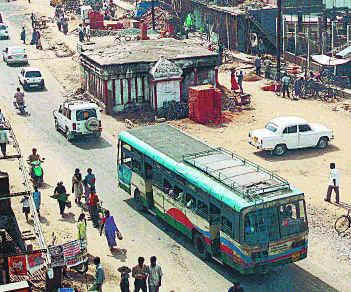 Adele
persuaded
Balasingham
to
tell
Pirapaharan
to
limit
his
visits
to
daytime
as
his
night
visits
were
disturbing
the
neighbourhood.
She
had
already
faced
an
ugly
incident
a
few
days
before.
Adele
persuaded
Balasingham
to
tell
Pirapaharan
to
limit
his
visits
to
daytime
as
his
night
visits
were
disturbing
the
neighbourhood.
She
had
already
faced
an
ugly
incident
a
few
days
before.
Thiruvanmiyur was a conservative Brahmin suburb of Chennai. Girls wore half sari and avoided mixing with boys. Adele, a white woman, was living with a Tamil man. That itself was strange. Added to that, all kinds of males visited that house during the day and night. Four girls were then brought. They were grown up, beautiful girls who wore skirts. Everyone who passed that way glanced at that house with suspicion. Gossip spread that a white woman was running a brothel.
One day, Adele relates in her book, a group of angry men gathered in front of their house and demonstrated shouting that that was a respectful place and threatening harm if they did not quit the area quickly. The men pelted stones at the house. Balasingham was not in at that time. There were no males in the house. The four girls huddled in a corner of their room, frozen.
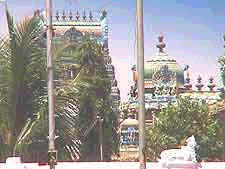 Sri
Marundeeswarar
Temple,
Thiruvanmuyir
Sri
Marundeeswarar
Temple,
Thiruvanmuyir
Fortunately, Ponnamman arrived with a group of cadres. Seeing the crowd, he was shocked. When he realized the reason for the demonstration he was more shocked. He shouted at the crowd. He told them they were Tamil freedom fighters from Sri Lanka. He told them they were there because the Indian government had brought them for arms training. To prove his claims he pulled the revolver from his waist and showed it to them. The demonstrators were stunned. Anger turned into admiration. They apologized for their mistake and thereafter their gaze conveyed their respect.
Balasingham told Pirapaharan that they should respect the cultural norms and practices of the neighbours and it would damage their image if he were found talking to Mathi at night.
The Marriage
Pirapaharan’s love affair landed him in trouble with his competitors and with his organization. His competitors, especially PLOTE of Uma Maheswaran, seized this opportunity to attack Pirapaharan. Within his organization, the LTTE, also there was criticism. Some seniors felt that Pirapaharan was violating his own moral code.
"That was one of the most trying periods for Pirapaharan," Santhosam told me.
Pirapaharan turned to Adele and Balasingham for help. Adele, more than Balasingham, stood by Pirapaharan. She was not, even during the Uma Maheswaran- Urmila episode, comfortable with the rigid LTTE code which barred marriage. She argued that the code should be more flexible. It should take into account human emotions.
Adele’s support for flexibility prompted Balasingham to take the stand that if Uma Maheswaran married Urmila the matter could be settled. The problem arose because Uma and Urmila denied their relationship and declined to marry each other. Balasingham adopted the same stand in Pirapaharan- Mathi affair also.
Balasingham handled the Pirapaharan-Mathi affair very carefully. He did not want that to the cause for another split. He called Pirapaharan’s senior and closest cadres to Chennai. Some of them had already expressed their opposition to Pirapaharan’s love affair. They maintained that it was a violation of the organization’s code of conduct. They repeated the same argument Pirapaharan used against Uma Maheswaran. They said the leader who devised the disciplinary rules should not break them.
Balasingham reminded them of the compromise he had then suggested. He told them that he advocated flexibility. He had suggested to Uma and Urmila a flexible compromise. They declined to accept the compromise and get married. He informed the other LTTE leaders that he proposed to suggest the same formula to Pirapaharan and Mathi.
Then, Balasingham proceeded to argue for the need for flexibility. I will quote Adele on that:
"Bala explained that the old moral code of the organization was rigid and puritanical and had to be changed to keep abreast with the time. He also argued that romance and heroism were values upheld in Tamil culture. Pirapaharan’s love relationship had the potential to revolutionize the organization by making available to the cadres the possibility of a fulfilling love relationship, marriage and family life for them also in the future. This turn of events should be viewed as a positive development in the growth and development of the organization."
Adele says the senior colleagues reluctantly accepted Balasingham’s plea. I learnt from two seniors I talked to that they were actually placed on the horns of a dilemma. They said they realized that Pirapaharan was infatuated with Mathi. Any attempt by them to break their relationship would affect him psychologically and emotionally. They said Adele was keen on helping Pirapaharan and she met the cadres individually and told them, "Please understand this. Marriage will do Pirapaharan good. It will also do the organization good. Don't stand in the way."
The senior leaders told Balasingham that the LTTE’s code of conduct should be suitably amended
to permit Pirapaharan to marry Mathi. They told Balasingham that that amendment should be a general rule and not an exception. Balasingham welcomed the suggestion and formulated the general rule which allowed those who served the organization for five years the freedom to marry.Pirapaharan’s marriage had a profound effect on the organization. One by one many senior cares married and marriage and family life became the norm in the LTTE.
Balasingham told Pirapaharan that he should marry soon and preferably with the consent of Mathi’s parents. Balasingham arranged for Earambu Master and his wife Sinnammal to travel to Chennai. Balasingham told them that their daughter had fallen in love with Pirapaharan and the best course of action available now was to get them married. He told them to talk to their daughter and decide her future.
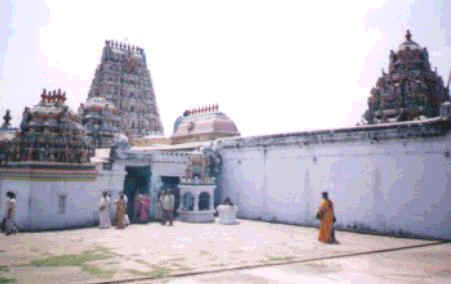 Kandaswamy
Temple,
Thiruporur
Kandaswamy
Temple,
Thiruporur
Mathi’s parents gave their consent after discussing the matter with her. A relative of Earambu master told me that he had explained to his daughter the difficulties she would face if she married Pirapaharan, a guerrilla leader wanted by the Sri Lankan government. "Your life will be in eternal danger, I warned her. She said she is prepared to sacrifice her life for his sake. I had nothing more to say. I gave my consent," Earambu Master had told his relative.
The marriage took place on 1 October 1984 at Thiruporur Murugan Temple in Tamil Nadu. Pirapaharan is a devotee of the Hindu deity Murugan, a God of Action and Destroyer of Evil. The wedding was a simple ceremony. After the wedding Mathi left Balasingham’s house and lived with Pirapaharan.
TELO Girls
Before Pirapaharan and Mathi's wedding Adele and Balasingham moved to a bigger house in Thiruvanmiyur. They needed a bigger house because more girls had joined them. That also was an unexpected addition. Along with the thousands of angry young men a number of girls wanted to join the militant groups to receive military training. But the LTTE, PLOTE and EROS refused to take them, saying that they had not yet formed women’s wings.
TELO leader Sri Sabaratnam took girls who volunteered. He transported them to the TELO camp in Tamil Nadu. There the girls found that no proper arrangements had been made to accommodate them. They found that a women’s wing had not been organized. They realized that no one had been appointed to look after them. The girls were stranded. They approached a Catholic priest for help. The priest asked Pirapaharan to do something to help the girls. Pirapaharan told the priest that he also had not formed a women’s wing, but would form one when sufficient numbers joined. He offered to provide accommodation to the stranded girls till he founded the women’s wing. He sent the girls to Adele.
The TELO group included Sothia, Sugi, Theepa, Imelda, Vasanthi, Jeya, Lalitha and Santhi. They were all trailblazers in the Tamil freedom struggle. Sothia was the first woman leader of the LTTE’s military wing, Sugi was the first to fire an RPG at a military sentry point, Theepa was an instructor at the LTTE’s first training camp in Jaffna for women cadres, Lalitha was the director of Sensolai, a residential school for orphaned girls and children, and Santhi headed the women’s intelligence wing.
With the addition of the TELO girls the Balasinghams rented a larger house in Thruvanmiyur and moved into it. Adele and Balasingham occupied an upstairs room which opened onto a balcony. The girls occupied the ground floor. When Mathi moved out after marriage to live with Pirapaharan, the remaining girls in October 1984 were sent to Madurai, where the first military training program for LTTE women cadres was conducted. The Balasinghams then moved into a smaller seaside two-roomed flat in Besant Nagar, a suburb of Chennai.
The first three years of Mathi’s married life were pleasant and she bore two children during that time. The eldest was a boy, born in 1985, named Charles Anthony, after Pirapaharan's trusted lieutenant Charles Anthony Seelan whose death on 15 July 1983 led to the retaliatory Thirunelveli attack, the turning point in Sri Lankan history. The second child, born in June 1986, was a girl. She was named Thuwarakai after one of the LTTE’s early martyrs. T he third child, a boy, born ten years later, was named after Mathi’s younger brother Balachandran who was killed by the Indian army.
Mathi is leading a backstage life. Occasions on which she came into the open with Pirapaharan are rare. The first occasion in which Pirapaharan brought Mathi with him was in 1985 during an interview he gave to Indian journalist Anita Pratap. In her book Island of Blood Anita Pratap records that occasion thus:
Once, in the mid-1980s in Madras, Pirapaharan brought his wife and three-month-old son along for the interview… As she sat by his side during the interview, Pirapaharan’s wife did not speak even once out of turn. She wore a printed wrinkle-free sari and a modest blouse. She seemed gentle and domesticated. At his request, she handed him his son. ‘His name,' said Pirapaharan looking down at his infant, ‘is Charles Anthony.’
Anita Prathap’s comment about the naming of the child:
I realized then that loyalty begets loyalty. The reason LTTE cadres are so loyal to Pirapaharan is because his loyalty to them is legendary.
Seelan’s loyalty to Pirapaharan is also legendary. Sarath Munasinghe in his book A Soldier’s Version has this on page 76:
Seelan has told her (Nirmala Nithiyananthan) that Pirapaharan was a great leader. One day, when a sick LTTE member wanted to vomit, from his sick bed, Pirapaharan has held out his hands together for the sick person to vomit. Jokingly, I told Nirmala, "I will get hold of your Seelan one day," she replied, "Please do not try that. You will never get him alive."
And I have told in the first volume of this series that Sarath Munasinghe only got Seelan's body. Pirapaharan rewarded Seelan’s loyalty and self sacrifice by naming his son Charles Anthony.
Mathi, a stout Hindu, did not object to giving their eldest son a Christian name. She respected Pirapaharan’s sentiments and led a very supportive life. Her dedication and selfless sacrifice have won for her the admiration of all who have known her.
Adele Balasingham has this in her book The Will to Freedom:
In choosing Mathi as his wife, Pirapaharan was more than blessed, for over the years of their marriage she has provided him with unwavering love and surrounded him with the security and warmth of family life; often under very difficult conditions and situations. It has not been a bed of roses for Mathi. A very gentle and tender character, she has had to rise to the occasion in many instances and overcome several emotionally stressful circumstances.
During the first three years Mathi lived in Chennai she had to live alone with the two infants as Pirapaharan spent most of his time organizing the training camps and overseeing the training. But she enjoyed peace of mind.
In December 1986 Mathi shifted to Jaffna when Pirapaharan decided to move to the northern province to wage the struggle against the Sri Lankan state from the Tamil homeland. There she lived in a hideout in Nallur. Her parents joined her. She went through many anxious moments when Sri Lankan air force bombers and helicopters targeted her husband.
Mathi was in her Nallur hideout when the Indian Peace Keeping Force (IPKF) entered Jaffna town in October 1987. She took refuge with the two children in Nallur Kandasamy Kovil along with the people of the area. That was one of the most anxious moments in her life. The Indian army was searching everywhere to arrest her husband and she was in the area the Indian forces had captured.
When the situation eased, she left the two children in the care of her parents and joined her husband in the Alampil jungles of Manal Aru in the Mullaitivu district. Her life at Alampil was a period of mental torment. The ceaseless Indian artillery bombardment of the LTTE hideout inside the bosom of the thick forest, the inching advance of the fierce Indian regiments, the news about the death of her younger brother Balachandran in combat and, above all, the separation from her toddler children emotionally shook her.
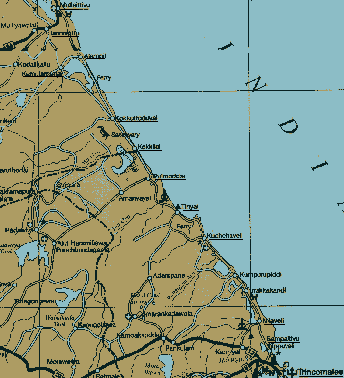
Pirapaharan could not bear her suffering. He decided to send her abroad. She resisted. Pirapaharan insisted. Eventually her escape to Jaffna, where she rejoined her children, and then to Sweden were arranged. The story of this thrilling escapade remains untold. The general belief during that time was that she had gone to Australia.
Mathi led a secret life with her children in Sweden for nearly two years. She was reunited with her husband in late 1989. President Premadasa, with whom the LTTE commenced talks in April 1989, granted permission and made arrangements for Mathi’s return. Mathi and her children were flown to Singapore. She joined Balasingham and Adele at Singapore and flew to Katunayake with them. Premadasa ordered that a special helicopter take Balasingham, Adele and Mathi and her children to an undisclosed destination in Alampil.
"Throughout the years of her marriage," Adele comments in her book, "Mathi has never known a permanent home and safe family life. Nevertheless, she has lived out the role of the wife to a guerilla leader with great courage and dignity and consistently struggled to provide a stable life for her children."
Next
Chapter 14. JR’s Three Track Policy
To be posted September 3